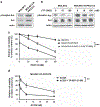Receptor tyrosine kinase Axl is required for resistance of leukemic cells to FLT3-targeted therapy in acute myeloid leukemia
- PMID: 26172401
- PMCID: PMC8145983
- DOI: 10.1038/leu.2015.147
Receptor tyrosine kinase Axl is required for resistance of leukemic cells to FLT3-targeted therapy in acute myeloid leukemia
Abstract
In acute myeloid leukemia (AML), about 25-30% of patients harbor a constitutively active receptor tyrosine kinase (RTK) FLT3 encoded by a FLT3 allele harboring internal tandem duplication (FLT3-ITD) mutation. The presence of FLT3-ITD correlates with poor prognosis in AML and it makes FLT3 an attractive therapeutic target in AML. Unfortunately, to date small-molecule inhibitors of FLT3 have resulted in only partial and transient clinical responses with residual leukemic blasts resistant to FLT3 inhibitors detected in blood or bone marrow. In this study, we investigated whether the RTK Axl is responsible for resistance of FLT3-ITD(+) AML cells to PKC412 and AC220, FLT3 inhibitors currently under clinical trials for FLT3-ITD(+) AML patients. Upon treatment with PKC412 or AC220, phosphorylation of Axl was significantly enhanced in the FLT3-ITD(+) MV4-11 AML cell line and in primary blasts from a FLT3-ITD(+) AML patient. Consistently, a PKC412-resistant AML cell line and PKC412-resistant primary blasts from FLT3-ITD(+) AML patients had significantly higher levels of constitutively phosphorylated Axl and total Axl when compared with a PKC412-sensitive AML cell line and PKC412-sensitive primary blasts from FLT3-ITD(+) AML patients. We also found that resistance of AML cells against the FLT3 inhibitor PKC412 and AC220 was substantially diminished by the inhibition of Axl via a small-molecule inhibitor TP-0903, a soluble receptor Axl fusion protein Axl-Fc or knockdown of Axl gene expression by shRNA. Collectively, our study suggests that Axl is required for resistance of FLT3-ITD(+) AML cells against the FLT3 inhibitor PKC412 and AC220, and that inhibition of Axl activation may overcome resistance to FLT3-targeted therapy in FLT3-ITD(+) AML.
Conflict of interest statement
CONFLICT OF INTEREST
SLW and DJB are employees of and shareholders in Tolero Pharmaceuticals, Inc. The remaining authors declare no conflict of interest.
Figures





Similar articles
-
Inhibition of the receptor tyrosine kinase Axl impedes activation of the FLT3 internal tandem duplication in human acute myeloid leukemia: implications for Axl as a potential therapeutic target.Blood. 2013 Mar 14;121(11):2064-73. doi: 10.1182/blood-2012-07-444018. Epub 2013 Jan 15. Blood. 2013. PMID: 23321254 Free PMC article.
-
Mechanisms of resistance against PKC412 in resistant FLT3-ITD positive human acute myeloid leukemia cells.Ann Hematol. 2010 Jul;89(7):653-62. doi: 10.1007/s00277-009-0889-1. Epub 2010 Jan 30. Ann Hematol. 2010. PMID: 20119833
-
Targeting rapid TKI-induced AXL upregulation overcomes adaptive ERK reactivation and exerts antileukemic effects in FLT3/ITD acute myeloid leukemia.Mol Oncol. 2025 May;19(5):1386-1403. doi: 10.1002/1878-0261.13749. Epub 2024 Oct 12. Mol Oncol. 2025. PMID: 39395205 Free PMC article.
-
Midostaurin/PKC412 for the treatment of newly diagnosed FLT3 mutation-positive acute myeloid leukemia.Expert Rev Hematol. 2017 Dec;10(12):1033-1045. doi: 10.1080/17474086.2017.1397510. Epub 2017 Oct 30. Expert Rev Hematol. 2017. PMID: 29069942 Review.
-
Targeting FLT3 to treat leukemia.Expert Opin Ther Targets. 2015 Jan;19(1):37-54. doi: 10.1517/14728222.2014.960843. Epub 2014 Sep 18. Expert Opin Ther Targets. 2015. PMID: 25231999 Free PMC article. Review.
Cited by
-
Concomitant targeting of FLT3 and SPHK1 exerts synergistic cytotoxicity in FLT3-ITD+ acute myeloid leukemia by inhibiting β-catenin activity via the PP2A-GSK3β axis.Cell Commun Signal. 2024 Aug 7;22(1):391. doi: 10.1186/s12964-024-01774-9. Cell Commun Signal. 2024. PMID: 39113090 Free PMC article.
-
Brigatinib, a newly discovered AXL inhibitor, suppresses AXL-mediated acquired resistance to osimertinib in EGFR-mutated non-small cell lung cancer.Acta Pharmacol Sin. 2024 Jun;45(6):1264-1275. doi: 10.1038/s41401-024-01237-4. Epub 2024 Mar 4. Acta Pharmacol Sin. 2024. PMID: 38438582 Free PMC article.
-
TP-0184 inhibits FLT3/ACVR1 to overcome FLT3 inhibitor resistance and hinder AML growth synergistically with venetoclax.Leukemia. 2024 Jan;38(1):82-95. doi: 10.1038/s41375-023-02086-6. Epub 2023 Nov 25. Leukemia. 2024. PMID: 38007585
-
Clinical profile of gilteritinib in Japanese patients with relapsed/refractory acute myeloid leukemia: An open-label phase 1 study.Cancer Sci. 2018 Oct;109(10):3235-3244. doi: 10.1111/cas.13749. Cancer Sci. 2018. PMID: 30039554 Free PMC article. Clinical Trial.
-
AXL confers intrinsic resistance to osimertinib and advances the emergence of tolerant cells.Nat Commun. 2019 Jan 16;10(1):259. doi: 10.1038/s41467-018-08074-0. Nat Commun. 2019. PMID: 30651547 Free PMC article.
References
-
- Brown P, Small D. FLT3 inhibitors: a paradigm for the development of targeted therapeutics for paediatric cancer. Eur J Cancer 2004; 40: 707–721, discussion; 722–724. - PubMed
-
- Knapper S FLT3 inhibition in acute myeloid leukaemia. Br J Haematol 2007; 138: 687–699. - PubMed
-
- Stirewalt DL, Radich JP. The role of FLT3 in haematopoietic malignancies. Nat Rev Cancer 2003; 3: 650–665. - PubMed
-
- Gilliland DG, Griffin JD. The roles of FLT3 in hematopoiesis and leukemia. Blood 2002; 100: 1532–1542. - PubMed
-
- Whitman SP, Archer KJ, Feng L, Baldus C, Becknell B, Carlson BD et al. Absence of the wild-type allele predicts poor prognosis in adult de novo acute myeloid leukemia with normal cytogenetics and the internal tandem duplication of FLT3: a cancer and leukemia group B study. Cancer Res 2001; 61: 7233–7239. - PubMed
Publication types
MeSH terms
Substances
Grants and funding
LinkOut - more resources
Full Text Sources
Other Literature Sources
Medical
Research Materials
Miscellaneous

